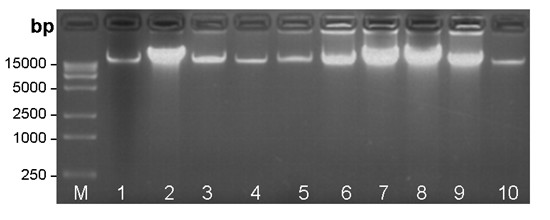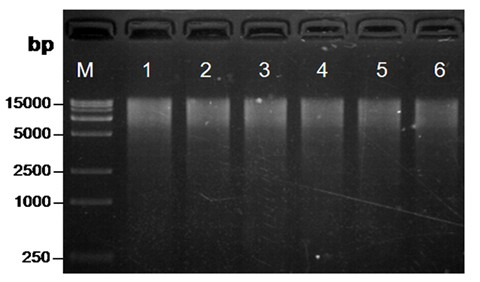Method for efficiently extracting tropical plant DNA
A tropical plant, high-efficiency technology, applied in DNA preparation, recombinant DNA technology, etc., can solve the problems of high environmental damage and low safety of extraction process
- Summary
- Abstract
- Description
- Claims
- Application Information
AI Technical Summary
Problems solved by technology
Method used
Image
Examples
Embodiment 1
[0030] The extraction process of the DNA of Chrysanthemum chrysanthemum provided by this implementation is as follows:
[0031] (1) Take Chrysanthemum chrysanthemum leaves as raw materials, collect the young leaves, mature leaves and old leaves of the same plant and mix them into one sample, store them in liquid nitrogen immediately, and then use a sterile grinding rod to place them in a liquid nitrogen container. The leaves were ground into powder in a mortar, and about 100 mg of tissue powder was taken from each sample for DNA extraction, and the remaining tissue powder was stored in a -80°C refrigerator for later use;
[0032](2) Preheat the lysis buffer of the present invention at 65°C;
[0033] (3) Add about 100 mg of ground powder into a 2.0 mL sterile EP tube, immediately add 1.0 mL of the lysis buffer of the present invention, and mix well;
[0034] (4) Put the above lysis buffer in a 65°C water bath for 30 minutes, and mix it every 5 minutes;
[0035] (5) Centrifug...
Embodiment 2
[0041] In this embodiment, the leaves of the king coconut tree are used as raw materials, and young leaves, mature leaves and old leaves of the same plant are collected and mixed into a sample, which is immediately stored in liquid nitrogen. Afterwards, the leaves were ground to a powder using sterile grinding rods in a mortar filled with liquid nitrogen. About 100 mg of tissue powder was taken from each sample for DNA extraction. The remaining tissue powders were stored in a -80°C refrigerator for future use.
[0042] The extraction steps are as follows:
[0043] (1) Preheat the lysis buffer of the present invention at 60°C,
[0044] (2) Put about 1 g of fresh plant leaves into a mortar filled with liquid nitrogen and quickly grind them to powder;
[0045] (3) Add about 100 mg of ground powder into a 2.0 mL sterile EP tube, immediately add 2.0 mL of the lysis buffer of the present invention, and mix well;
[0046] (4) Water bath at 60°C for 40 minutes, and mix well every ...
Embodiment 3
[0053] In this embodiment, the leaves of the papaya tree are used as raw materials, and young leaves, mature leaves and old leaves of the same plant are collected and mixed into a sample, which is immediately stored in liquid nitrogen. Afterwards, the leaves were ground to a powder using sterile grinding rods in a mortar filled with liquid nitrogen. About 100 mg of tissue powder was taken from each sample for DNA extraction. The remaining tissue powders were stored in a -80°C refrigerator for future use.
[0054] The extraction steps are as follows:
[0055] (1) Preheat the lysis buffer of the present invention at 70°C;
[0056] (2) Put about 1 g of fresh plant leaves into a mortar filled with liquid nitrogen and quickly grind them to powder;
[0057] (3) Add about 100 mg of ground powder into a 2.0 mL sterile EP tube, immediately add 1.5 mL of the lysis buffer of the present invention, and mix well;
[0058] (4) 70°C water bath for 20 minutes, and mix once every 5 minutes...
PUM
 Login to View More
Login to View More Abstract
Description
Claims
Application Information
 Login to View More
Login to View More - R&D
- Intellectual Property
- Life Sciences
- Materials
- Tech Scout
- Unparalleled Data Quality
- Higher Quality Content
- 60% Fewer Hallucinations
Browse by: Latest US Patents, China's latest patents, Technical Efficacy Thesaurus, Application Domain, Technology Topic, Popular Technical Reports.
© 2025 PatSnap. All rights reserved.Legal|Privacy policy|Modern Slavery Act Transparency Statement|Sitemap|About US| Contact US: help@patsnap.com



